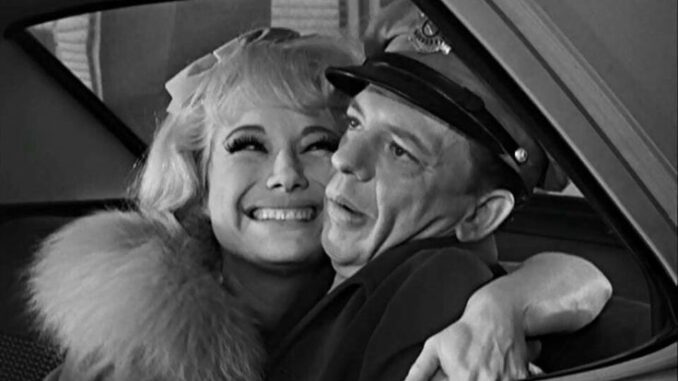
The Man from U.N.C.L.E. star thought his friend deserved to be the next Carol Burnett, but she was typecast.
In Mayberry, a pair of gal pals named Daphne and Skippy, known as the “Fun Girls,” showed up a few times to shake things up on The Andy Griffith Show. Daphne usually ended up on Andy’s arm, and Skippy on Barney’s.
Usually, we think of the two actors who played the Fun Girls — Jean Carson and Joyce Jameson — as an inseparable pair, but today we want to take a moment to split the duo and give Joyce Jameson a little special attention.
Because, as it turns out, Jameson did have a best friend who stuck by her side and considered her one of the most “fun girls” he ever met. That friend was The Man from U.N.C.L.E. star Robert Vaughn.
Vaughn described his special friendship with Jameson in his autobiography, A Fortunate Life.
“She was the most fascinating girl I ever met,” Vaughn wrote.
He said they met in 1957, well before The Man from U.N.C.L.E. premiered in 1964, when Vaughn was invited by Ken Berry’s future wife, Jackie Joseph, to watch the Billy Barnes Revue.
“You ought to come and see the show,” Jackie said. “You’ll like it. And Joyce is the woman for you. She’s sexy, funny, smart, and she does a terrific Marilyn Monroe.”
Vaughn was sold, so he went to the show, where he and Jameson instantly clicked. She became his girlfriend, his longest relationship as a bachelor, he said.
“She moved in, out, and through my life for the next dozen years,” Vaughn wrote, remembering that he found Joyce to be everything Jackie promised “and more.”
At that point, Jameson was known for her impressions. She could do Marilyn Monroe, Shirley Temple, Judy Garland or Bette Davis at the drop of a hat. But she was best known for her Marilyn.
One review in a “Hollywood Today” column joked that Marilyn Monroe could sleep easier when Jameson stopped doing her “devastating” impression of the pop icon. That decision came at a moment when Jameson hoped to do more with her career than lean into playing ditzy blondes. One show that allowed her to show her range was The Waltons, which cast her as a dance contestant in “The Marathon.” She breaks down crying and screams, “Spanky, no!”
But she never could escape the “dumb blonde” stereotype, and over time, Vaughn said he watched his former girlfriend and longtime friend grow depressed.
Vaughn remained her friend until the end, at one point insisting that she see a psychiatrist, but in 1984, Jameson took her own life, tragically, just like Marilyn Monroe.
“On The Steve Allen Show, she created a character that she called her ‘dummy,'” Vaughn said. “Her dummy was the Honee Girl, and she was Joyce’s take on a Marilyn Monroe type who she identified with personally, the Hollywood blonde whose life ended tragically.”
Vaughn knew early on that there was so much more to Jameson than her impressions and the empty-headed girls she played.
“Critics called Joyce the most versatile comedienne with sex appeal of her era,” Vaughn said. “I agreed.”
Unfortunately, Jameson soon became irreversibly typecast for playing ditzy blondes, and Vaughn said this ended up limiting how much fame she could hope to achieve. He thought if people knew how witty, funny and smart she was, she could’ve been as big as Carol Burnett.
“Her greatest professional shortcoming was her inability to present the same pleasing, warm personality to an audience,” Vaughn said, explaining she could pivot between many different personalities that he described as “pleasant, provocative and fun to be with.”
“This was the fatal flaw that prevented her from enjoying the kind of career she otherwise enjoyed — hosting a comedy show on television, like the one featuring the well-loved Carol Burnett,” Vaughn said.
